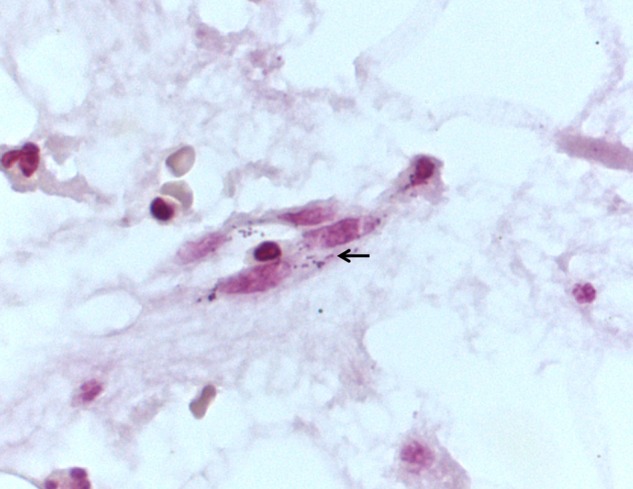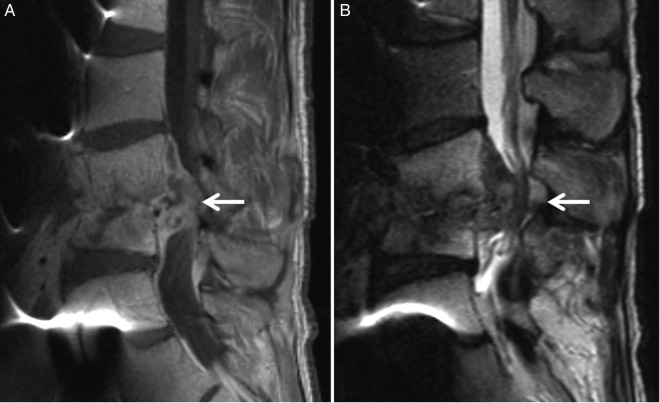Abstract
Coxiella burnetii is a rare cause of chronic infection that most frequently presents as endocarditis. We report a case of C burnetii causing an infected abdominal aortic aneurysm with contiguous lumbar osteomyelitis resulting in spinal cord compromise. The diagnosis was established by serologic studies consistent with chronic Q-fever (ratio of C burnetii immunoglobulin [Ig]G phase II titer to IgG phase I titer <1) and was confirmed by positive C burnetii polymerase chain reaction of vertebral tissue in addition to pathology of vertebral bone showing intracellular Gram-negative coccobacillary bacteria. The patient clinically improved after surgical decompression and prolonged treatment with doxycycline and hydroxychloroquine.
Keywords: abdominal aortic aneurysm, chronic Q-fever, Coxiella burnetii, osteomyelitis, Q-fever
CASE REPORT
A 57-year-old Jordanian male with a past medical history of emphysema and tobacco use developed lower back pain with intermittent fevers in July 2014. A magnetic resonance image (MRI) of the lumbar spine revealed vertebral osteomyelitis at L3-L4 and incidentally detected an 8.1 cm infrarenal abdominal aortic aneurysm (AAA). He received several empiric courses of oral antibiotics with no clinical improvement. He worked as an ophthalmologic surgeon in Amman, Jordan where he was born. He had no relevant sick contacts or animal exposures but endorsed possible consumption of unpasteurized milk in his childhood.
While en route to the United States for medical evaluation, he became acutely ill in London requiring admission for septic shock. He was started on broad-spectrum antibiotics and underwent emergent endovascular aneurysm repair with stenting in September 2014. Five days later, he suffered an endovascular leak resulting in a large retroperitoneal hematoma requiring open surgical exploration and resection. No growth was detected in serial blood cultures. Tissue cultures of the hematoma, including 16 s RNA universal polymerase chain reaction (PCR), and routine, fungal, and acid-fast bacilli (AFB) cultures remained negative. Serologic testing for syphilis, human immunodeficiency virus, and Brucella were negative. The patient was treated empirically with intravenous antibiotics for 8 weeks before returning to Jordan to continue suppressive oral antibiotics.
In March 2015, his chronic lumbar pain worsened. Repeat computed tomography imaging of the spine showed progressive L3-L4 osteomyelitis and a new right intramuscular psoas fluid collection. Due to new lower extremity weakness, the patient traveled to the United States for further management in April 2015. Repeat MRI of the lumbar spine revealed progressive osteomyelitis at L3-L4 with epidural abscess causing spinal cord compression (Figure 1). He underwent emergent surgical decompression with laminectomy and fusion; intraoperatively, he had grossly purulent material at the L3-L4 disk space.
Figure 1.
Contrast-enhanced T1 (A) and T2-weighted (B) magnetic resonance imaging of the lumbar spine with evidence of chronic osteomyelitis at L3-L4 with large epidural phlegmon (arrows) and multiple small epidural abscesses resulting in high grade spinal stenosis with spinal cord compression.
Evidence of lumbar osteomyelitis associated with a presumptively infected AAA, and serial negative cultures prompted serologic testing for Q-fever. Coxiella burnetii titers by immunofluorescence assay (Focus Diagnostics) confirmed a pattern consistent with chronic Q-fever: immunoglobulin (Ig)G phase I 1:2048 and IgG phase II 1:1024 (reference range <1:16). Surgical pathology of vertebral bone demonstrated osteomyelitis, granuloma, and intracellular Gram-negative coccobacilli (Figure 2). Routine, fungal, and AFB tissue cultures were negative. Real-time PCR for C burnetii aroE (shikimate dehydrogenase gene) performed on bone tissue at Mayo Clinic Laboratories was positive. The patient is being treated with doxycycline plus hydroxychloroquine with plans for lifelong suppression given retained endovascular and orthopedic hardware. He regained normal sensation in his lower extremities with near-normal gait 3 months postoperatively.
Figure 2.

Brown-Brenn stain of L3-L4 vertebral bone showing intracellular Gram-negative coccobacillary bacteria (arrow) consistent with Coxiella burnetii within the cytoplasm of histiocytes (magnification, 1000×).
DISCUSSION
Coxiella burnetii is a ubiquitous, obligate intracellular Gram-negative coccobacillus. Cattle and sheep are the most common animal reservoirs and shed the bacteria in urine, feces, milk, and birth products. Aerosolized particles containing C burnetii can cause human infection when inhaled and have been associated with large scale outbreaks primarily in Europe [1]. Because of its environmental resilience and high infectivity, C burnetii is a potential bioterrorism agent [2]. No culprit exposure history was elicited in our case. Primary infection is asymptomatic in up to 60% of patients but can result in a self-limited influenza-like illness termed “acute Q-fever” [3]. Acute infection can progress to chronic Q-fever, especially in individuals who are pregnant, immunocompromised, or have underlying valvular heart disease. The most common manifestations of chronic infection are endocarditis (73% cases) and endovascular infection (8% cases), including vascular grafts and aneurysms [4]. Infection of infrarenal aortic aneurysm grafts with contiguous vertebral osteomyelitis has been described [5, 6].
A diagnosis of chronic Q-fever can be made by clinical presentation, serology, molecular testing, and tissue culture. Antigenic phase variation in the lipopolysaccharide and sugar composition of C burnetii isolates allows for the serologic distinction of acute versus chronic disease. A ratio of C burnetii IgG phase II to phase I titer greater >1 is consistent with acute disease, whereas a ratio <1 is consistent with chronic disease, especially when IgG phase I titer is ≥1:600 [7]. Polymerase chain reaction-based detection of C burnetii in blood and tissue samples using a validated real-time PCR assay is invaluable for early diagnostic confirmation, as we demonstrated in this case [8]. Coxiella burnetii should be cultured in a level 3 biosafety laboratory and is technically challenging so it is not routinely performed [2, 3].
Treatment of C burnetii endovascular infection and osteomyelitis is extrapolated from endocarditis treatment recommendations. Guidelines from the British Society of Antimicrobial Therapy recommend treatment with doxycycline in combination with either hydroxychloroquine or ciprofloxacin for a minimum of 18 months [9]. Coxiella burnetii lives in the phagolysosome of infected cells in a relatively acidic environment that reduces doxycycline bactericidal activity. The addition of hydroxychloroquine increases the pH of the phagolysosome to selectively enhance the bactericidal activity of doxycycline. Patients can be considered cured when C burnetii IgG phase I antibodies decline to <1:800 and IgM/IgA phase I antibodies are <1:50 [9].
CONCLUSIONS
Coxiella burnetii endovascular infection is associated with significant morbidity and mortality and can evade clinical recognition for months before effective treatment is initiated. This case highlights the importance of early testing for C burnetii in patients with abdominal aortic aneurysm, prodromal symptoms, laboratory findings (ie, elevated inflammatory markers) suggestive of infectious etiology, and negative routine cultures.
Acknowledgments
We thank Dr. Alison Rapoport for assistance with editing the manuscript.
Potential conflicts of interest. All authors: No reported conflicts.
All authors have submitted the ICMJE Form for Disclosure of Potential Conflicts of Interest.
References
- 1.Hackert VH, van der Hoek W, Dukers-Muijrers N et al. . Q fever: single-point source outbreak with high attack rates and massive numbers of undetected infections across an entire region. Clin Infect Dis 2012; 55:1591–9. [DOI] [PubMed] [Google Scholar]
- 2.Madariaga MG, Rezai K, Trenholme GM, Weinstein RA. Q fever: a biological weapon in your backyard. Lancet Infect Dis 2003; 3:709–21. [DOI] [PubMed] [Google Scholar]
- 3.Maurin M, Raoult D. Q fever. Clin Microbiol Rev 1999; 12:518–53. [DOI] [PMC free article] [PubMed] [Google Scholar]
- 4.Sessa C, Vokrri L, Porcu P et al. . Abdominal aortic aneurysm and Coxiella burnetii infection: report of three cases and review of the literature. J Vasc Surg 2005; 42:153–8.16012465 [Google Scholar]
- 5.Fournier PE, Casalta JP, Piquet P et al. . Coxiella burnetii infection of aneurysms or vascular grafts: report of seven cases and review. Clin Infect Dis 1998; 26:116–21. [DOI] [PubMed] [Google Scholar]
- 6.O'Donnell ME, Manshani N, McCaughey C et al. . Coxiella burnetii infection of an aortic graft with multiple vertebral body erosion. J Vasc Surg 2007; 45:399–403. [DOI] [PubMed] [Google Scholar]
- 7.Frankel D, Richet H, Renvoisé A, Raoult D. Q fever in France, 1985–2009. Emerg Infect Dis 2011; 17:350–6. [DOI] [PMC free article] [PubMed] [Google Scholar]
- 8.Tande AJ, Cunningham SA, Raoult D et al. . A case of Q fever prosthetic joint infection and description of an assay for detection of Coxiella burnetii. J Clin Microbiol 2013; 51:66–9. [DOI] [PMC free article] [PubMed] [Google Scholar]
- 9.Gould FK, Denning DW, Elliott TS et al. . Guidelines for the diagnosis and antibiotic treatment of endocarditis in adults: a report of the Working Party of the British Society for Antimicrobial Chemotherapy. J Antimicrob Chemother 2012; 67:269–89. [DOI] [PubMed] [Google Scholar]



